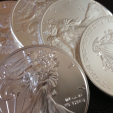Good Things Come in Small Packages
Having survived another holiday season, and after putting away most of the holiday decorations, my mind wandered as to what would be a good article to start off the New Year.
Certainly we could follow the general genre and produce a forecast for 2008 on the economy, metals prices, elections-however, it seems there is already enough of this out on the Internet already.
My musing took me back to challenge the general "non-thinking" consensus about the silver market and an opinion that I'm met with quite often. Without the myriad of twists on the basic question, let me make it a general statement.
Pure and simple, many people in and outside of the precious metals area have come to the conclusion that
"SILVER IS TOO BULKY."
Before going off on a rant about this general (mis)perception, it becomes a challenge for this writer to lead you to draw your own conclusions. I am sure many of you celebrated the season with presents gift-wrapped and put under a tree. In this tradition, boxes come in all shapes and sizes and it gave me pause to think just how much silver would fit into a 12" x 12" x 12" box. In other words, what is a cubic foot of silver in troy ounces?
Interestingly, the actual number surprised even me. I thought back to the number of times I have seen a box that size being opened and really never giving it a second thought.

A cubic foot of silver is actually 9,549 troy ounces. Hmm, that is almost two COMEX contracts. What is that worth at $15 per ounce silver? Simply, $143,235 in U.S. currency!
Now come the hard questions. . . .
Question #1. What do you have in your house that occupies one cubic foot that is worth more than $143,235?
But many readers will say this is hypothetical and silver is sold in various forms such as 1 oz., 10 oz., 100 oz., and 1000 oz. bars, not to mention coins-both old silver coinage, from the past (when silver was money and anything but would be fraud) to modern-day bullion coins and silver rounds (usually 1 troy ounce silver medallion privately minted). Alas, I digress slightly.
So, let's approach this in a slightly different way. How "bulky" is a practical amount of silver? Or perhaps better yet-how much space would a reasonable amount invested in silver require? Certainly, at this point you have realized you will not need to move your two automobiles out of the garage to "store" your silver investment.
Alright, let's take a look at the coin world. With the Silver "Eagle" Liberty (which has had a great deal of press lately), a roll of them in the mint-issued plastic container holds 20 coins (each coin is one troy ounce) and measures 1¾" x 1¾" x 2½". This volume is just over seven cubic inches, and again, at $15 silver, a roll would be valued at over $300. Stated another way, silver in this example is valued at $39 per cubic inch.
Question #2. What do you have in your house that occupies seven cubic inches and is worth more than $300?
Looking around, it hits me just how wrong I must be. My laptop surely is worth more per cubic inch than the very bulky silver, correct? My laptop measures 13" x 10½" x 1½" for a total of 205 cubic inches, and it cost $1600, or $7.80 per cubic inch.
It seems that from a fundamental standpoint, silver is a very high-priced commodity per unit volume. However, we have only examined part of the story. When people complain that silver is "too bulky," what they are usually implying is that silver has a much lower unit value per ounce than any of the other precious metals. This of course is a fact and you will receive no argument from me.
Gold is much denser than silver; to begin with, a one-ounce gold coin takes up less volume than a one-ounce silver coin, and the price differential is substantial. A one-troy-ounce gold coin in today's market is pushing toward US$900, where a one-ounce silver coin is perhaps 1/55 as much. So, compared to gold or platinum or even palladium, silver could be considered bulky.
However, if all things are relative, I must ask again: How bulky is silver, relative to the amount you want to own? I bring this up because according to the chart shown, which was obtained from CNNMoney.com (click here) and provides data in early 2003, the median net worth for the Baby Boomers was around $180,000, so just a ten percent allocation to the precious metals would be $18,000.
Now if we divided it up equally between silver and gold, we would be looking at approximately 10 one-ounce gold coins (~$900 per ounce) for a $9,000 purchase, and 55 times as many in silver coins, or about 550 coins. Those 550 (or more) coins would comprise about 28 rolls of Silver Eagles and require approximately 215 cubic inches-about as much space as my laptop computer.

I remember reading an article quite some time ago about the precious metals, and it was titled, "Precious Metals, Precious Little." I no longer have that article but do recall the point that people's perception and reality do not always jibe. The precious metals are called "precious" for a reason-yes, even lowly silver! For example, let's look at the precious metals again.
All the gold ever mined would fit into a storage room about 72 feet long, 72 feet tall, and 72 feet wide. (Think of a 5,200-square-foot house that's six stories tall.) In other words, all the gold ever discovered would fit into a cube measuring 22 meters on a side.
But let's not forget all-too-bulky silver, because all the silver ever mined would fit into a storage room about 180 feet long by 180 feet tall, and 180 feet wide. (A football field that's ten stories high.) In other words, all the silver discovered thus far would fit inside a cube measuring 55 meters on a side.
I must point out that the amount of refined silver bullion today (January 2008) is approximately 500 million ounces, which would be a cube about 37 feet per side, or, as I stated in one of my earlier articles (click here), a space smaller than most would imagine.
In that earlier article I stated, "Ever pay attention to your local gas station? The dimensions vary of course, but for fun I took a rough look at one close to my neighborhood. It stood 18 feet at the overhead and 40 feet by 60 feet. If we put ALL of the COMEX silver into a huge cube, it would cover this gas station's floor space and reach a height of six feet."
Perhaps you can now do a little relative thinking and ponder all the gas stations on Planet Earth. Under just one of them we could store all the COMEX Silver with plenty of room to spare!
So the next time someone tells you they would like to buy silver but it is too bulky, just tell them you will gladly trade your laptop computer for an equal volume of silver. Make sure you get it in writing first because contrary to popular opinion, silver is quite valuable per unit volume, yet it is the lowest per unit volume of the precious metals.
If you are not opposed to holding some "bulky silver," you might be interested in entering our contest for a chance to win a 100-troy-ounce bar! See our Web site at www.silver-investor.com for details.
January 10, 2008
David Morgan
Mr. Morgan has been published in numerous periodicals and throughout the Internet. He does a weekly audio report-Money, Metals, and Mining Review-for Kitco. He is hosted monthly on Financial Sense with Jim Puplava, and is often featured on HoweStreet.com,Resourceworldradio.com, The Korelin Economics Report, and The Opportunity Show.
Mr. Morgan was published in the Global Investor regarding Ten Rules of Silver Investing, which you can receive for free. His book Get the Skinny on Silver Investing is available on Amazon or the link provided. His private Internet-only newsletter, The Morgan Report, is $129.99 annually.
Contact information:
Information contained herein has been obtained from sources believed to be reliable, but there is no guarantee as to completeness or accuracy. Because individual investment objectives vary, this Summary should not be construed as advice to meet the particular needs of the reader. Any opinions expressed herein are statements of our judgment as of this date and are subject to change without notice. Any action taken as a result of reading this independent market research is solely the responsibility of the reader. Stone Investment Group is not and does not profess to be a professional investment advisor, and strongly encourages all readers to consult with their own personal financial advisors, attorneys, and accountants before making any investment decision. Stone Investment Group and/or independent consultants or members of their families may have a position in the securities mentioned. Investing and speculation are inherently risky and should not be taken without professional advice. By your act of reading this independent market research letter, you fully and explicitly agree that Stone Investment Group will not be held liable or responsible for any decisions you make regarding any information discussed herein.


















